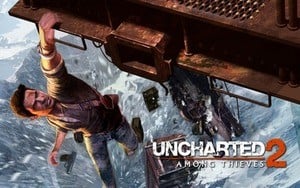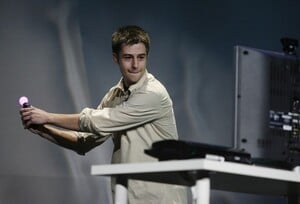
2009: Coming of Age
Every platform has a defining year, and for PlayStation 3, that came in 2009. While 2008 implemented a platform for change, it wasn’t until 2009 that those modifications came to the fore. A hearty rebranding effort saw the PlayStation 3 slimmed down into a new form factor and graced with a new logo. Sleeker, modernised, and, most importantly, now significantly cheaper, the PS3 finally seemed like an attractive proposition.
And it enjoyed its strongest period yet, thanks in part to the return of one Nathan Drake. Uncharted 2: Among Thieves – Sony’s biggest release of the year – scooped up copious game of the year awards and finally convinced gamers that PS3 was a force to be reckoned with.
Naughty Dog’s anticipated sequel not only set a new precedent for visual fidelity, but it also proved what was possible from a story-telling perspective. The ambitious love-triangle centring on protagonists Drake, Elena and Chloe proved that the medium was capable of engaging storytelling and believable characterisation in a way that few games had previously succeeded. The game went on to become one of the most discussed releases of 2009 – and its multiplayer was fairly well received too, despite the initial scepticism from fans and the media.
But while Uncharted 2 dominated conversation, it was Call of Duty that took the market by storm. Call of Duty 4: Modern Warfare had already been a surprise success on PS3 back in 2007, but after the disappointing World at War, all eyes were on Infinity Ward’s Modern Warfare 2. The sequel delivered, averaging a Metacritic of 94. While time has not been kind to MW2 – the plot seems incomprehensible upon reflection – Infinity Ward’s sequel cemented Call of Duty as the biggest brand in the world. The Activision shooter sold 4.7 million copies across multiple platforms in its first 24 hours on sale in the US and UK alone – a number which was only to be bettered by future Call of Duty releases.

Meanwhile, on the opposite end of the marketability scale, 2009 saw the arrival of a little known title called Demon’s Souls. Partially funded by Sony Computer Entertainment in Japan, and developed by FROM Software, the notoriously difficult fantasy action title was brought to North American shores by Atlus. The game quickly developed a cult following in the West, championed by gamers who felt that modern gaming was becoming too easy. The game went on to sell over half a million copies – forcing Sony Worldwide Studios president Shuhei Yoshida to later lament the company not bringing the title to Western shores itself.
On the whole, 2009 was a strong year for software on PS3. The gorgeous Killzone 2 launched early in the year and was joined by Resident Evil 5 and, later, inFamous – a rare new intellectual property which quickly developed a supercharged following. The PSN also started to stretch its legs, with the arrival of titles such as flower from thatgamecompany.
Meanwhile Sony found an unexpected new revenue stream via the PlayStation 3’s public removal of backwards compatibility. The God of War Collection – which was originally pitched as a Collector’s Edition bonus – launched in North America at the tail end of the year and went on to prompt a whole new series of compilations for Sony. The Sly Cooper Collection, ICO & Shadow of the Colossus Collection and Jak & Daxter Collection all followed, with many third-party studios getting in on re-release action too.
The PlayStation 3 was in its strongest position yet, and E3 reflected that. While the keynote hinged on the PSP go, the PS3 announcements came thick and fast. MAG promised the world’s first console 128-player multiplayer shooter – and delivered on that promise early in 2010. Other exclusives included ModNation Racers, Gran Turismo 5, The Last Guardian and God of War III.

And there was even time to reveal a new peripheral. In direct response to the announcement of Microsoft’s Project Natal, Sony wheeled out a hastily constructed tech demonstration dubbed the PlayStation Motion Controller. The nervous demonstration – anchored by Eye Toy creator Dr. Richard Marks – showed off the various capabilities of the device, many of which would form the basis for the peripheral’s launch software.
The battle between Microsoft’s Project Natal and Sony’s PlayStation Motion Controller went on to become a huge theme throughout the latter stages of 2009 and early 2010, with some arguing in favour of the practicality of Sony’s device, while others lamented its lack of creativity.
The rediscovered enthusiasm in the PlayStation platform as a whole set the tone for 2009, and Sony capitalised on the positive mind-share by releasing new ad campaigns across Europe and North America. The latter campaign would go on to become a phenomenon, with Kevin Butler playing the role of an arrogant PlayStation executive. The series of commercials – which saw Butler assume a different executive role for each new ad – were extremely clever, poking fun at the arrogant corporate image Sony had attained throughout the heady days of the PlayStation 2, and they brought a light-hearted tone to the platform for the first time since its release. Most importantly, both SCEA and SCEE’s new commercial campaigns focused on the PlayStation 3’s strengths, which were becoming increasingly important against the improving Xbox 360 and the runaway success of the Nintendo Wii.
Check back in the coming days to find out how the PlayStation 3 fared in 2010 and 2011. Meanwhile, let us know a little more about your history with the platform in the comments. Did you purchase a PS3 on launch day, or did you wait until the reboot in 2009? What titles did you purchase the system for, and were you satisfied with them?
Comments 13
2009 was a vintage year for PS3, it was the year I jumped ship from xbox 360 (after suffering ther dreaded RROD!) And although I got my 360 repaired I straight swapped it for a 40GB PS3, I have never looked back, thats untill My ps3 laser died two hours into uncharted 3. I was never going to give up and paid £70 for a repair (which was refunded by my house insurance!!) I have loads of great titles as well as two Move controllers and 1 navigation controller (nunchuck!!) And now my kids see it as a upgraded Wii, with eyepet etc. I love my PS3 and look forward to PS4. Also saving up for a Vita and Wont be buying Wii U (I have owned every Nintendo console, but will skip this one)
@LeonChamp Yeah, I imagine a ton of readers jumped on board in 2009. It really was the year that the system's fortunes changed.
I bought mine in 2009 as well. But that was my plan all along, once the price was more affordable.
I also have owned every Nintendo console, but will be skipping out on the Wii-U. I honestly just haven't heard anything that is a significant upgrade from the Wii. Besides I have played enough reiterations of Mario, Mario kart, smash bros, mario party to last a life time. Don't need another slightly improved knock off.
I bought the Metal Gear Solid 4 bundle PS3 in 2008, which followers of the feature will remember as the last model to ever include PS2 support. Yes, THAT'S why I bought it, not because of the game it came with (which I still haven't played to this day). It took me a little while to grow to love my new PS3 over my existing 360, but after the latter went RRoD the second time and was showing signs of wanting to do it again, I'd had enough and got rid of the fool thing altogether. Though there are some high-profile XBLA games I would like to play, I stand by this decision overall.
The first game I really wanted to get on my PS3 was indeed Uncharted: Drake's Fortune. My first Platinum Trophy (though that can be said of many people since it was the first to exist), it was a great game at the time (though it looks poor compared to its sequels now).
Sadly, my old machine died (YLOD) in late 2010, and I had to lose BC picking up a Slim (the Move bundle).
I was late to the party only had my PS3 since November. I debated PS3 or 360 for awhile in the end went with the PS3 and could not be happier. There are so many games I have yet to play but on the plus side all those old PS3 classics are cheap now and still brand new to me.
@Splat I actually envy you. What's still on the agenda?
Uncharted 3 is top of my must have list. Besides that off the top of my head Arkham Asylum,Arkham City,Infamous 2,Heavy Rain,Grand Theft Auto 4,Mass Effect (series) and Assassins Creed (series). That said the list is pretty much endless. My favorite Wii game of all time is Monster Hunter Tri so also looking for something close to that.
I like games. That's why I like PS3. The sheer number of quality exclusives is staggering, and I love it.
Bought mine in 2009 by coincidence, as it was the first time I could afford a used one heh. Have since got a new slim with move bundle and 17 platinums later I can say that I love the damn thing.
Sure the 360 has a better layout and UI, but who cares when I don't have 10-12 AAA exclusives to play every year. And as I've decided that this is my last ever console, I'm looking forward to the amazing end of life games that are on there way.
@seeafish
Last ever console? End of life games? What?
Bought mine in early 2010 because I wanted to play Heavy Rain. It was quickly followed by Assassins Creed II and I was hooked. I had no interest in the early days and the price was just silly. But the game ads in 2009 changed my mind. Was a PC gamer before then.
I now own a PS3 slim 320GB, Play TV, 4 Move Controllers, 1 Nav Controller, Sharp Shooter, Sony 5.1 Surround system, Logitech GT steering wheel and Hostas Flight stick. I even built my own gaming table for the wheel and flight stick.
My family room has effectively been taken over. Couldn't be happier!
I'm jumped into the PS3 boat quite early and it's been a long rough ride, but the top of the mountain sure is pretty. It's been a great life for the PS3 and it's only halfway through. Can't wait to see what next!
My brother bought the MGS4 bundle in 2008. I was really blown away by the games because I had, for the most part, skipped the previous generation of consoles(I owned a ps2 late, but most of my play was spent with my ps1 and on ps2-gamecube at friends houses). It seems strange but I effectively jumped from ps1 to ps3! I bought my own ps3 in 2009 just 3 weeks before the slim was released with the $100 price drop, though It was still worth it
Got my first PS3 on launch date 60gb backward compatible with PS1 and PS2 games. It got the YLOD but I was able to mod the PS3 with an internal Fan 2 years ago and it still running strong now. I had a Xbox360 and had to send it in twice due to the RROD. Xbox have a great online service but the variety exclusives are limited and not as inticing as the PS3. Now that I use Netflix and Hulu on my PS3, the free PSN service become more important. I dont want to pay twice to access my netflix with xbox live. I own a total of 3 ps3 (for each room) and my nintendo wii is now in the closet. Maybe after my kids are old enough, I can pull that out for them.
Tap here to load 13 comments
Leave A Comment
Hold on there, you need to login to post a comment...